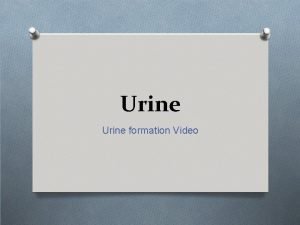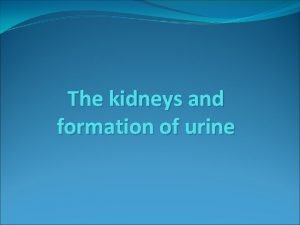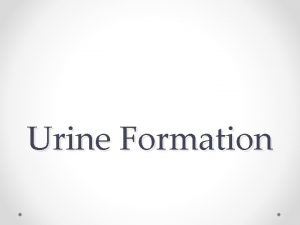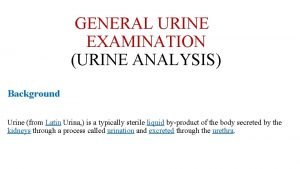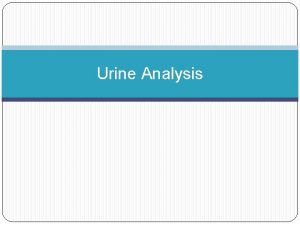FORMATION OF URINE The formation of urine occurs





- Slides: 5

FORMATION OF URINE The formation of urine occurs in three separate steps. http: //www. mhhe. com/biosci/ap/dynamichuman 2/content/gifs/0178 A. gif

FILTRATION The movement of fluids from the blood into the Bowman's capsule of the nephron. Blood moves from the afferent arteriole into the glomerulus (a high-powered filter, acting at 65 mm of Hg, ~1. 5 times the normal pressure of a capillary). Dissolved solutes pass from the blood into the Bowman's capsule along the pressure gradient. Not all solutes make it through. DO: DON'T (too large) Water Sodium chloride Glucose Amino acids protons -Plasma proteins -Red blood cells -Platelets

REABSORPTION The transfer of essential solutes and most water back into the surrounding cells and the blood stream. For every 120 m. L of fluid (amount filtered by kidneys each minute), 1 m. L of urine is formed, 119 m. L of fluid and solutes is reabsorbed. Occurs throughout the nephron, mainly in the proximal tubule and loop of Henle Occurs by active and passive transport.

WATER REABSORPTION Water is automatically reabsorbed back into the cells and bloodstream for 2 reasons: The blood that left the glomerulus by the efferent arteriole travels through the peritubular capillaries. It has a very high

SECRETION The release of substances into the filtrate from the blood and cells surrounding the nephron. Occurs mainly in the distal tubules and in the collecting duct, but some also occurs in the proximal tubule. Purpose: to release any toxins and drugs that have not been filtered Maintain the electrolyte balance of the body (if positive sodium ions are reabsorbed then positive ions like potassium must be secreted to keep the balance – even though reabsorbed intially). Acid-base balance (usually it is an acid being secreted, essentially a proton plus whatever it is attached to).



